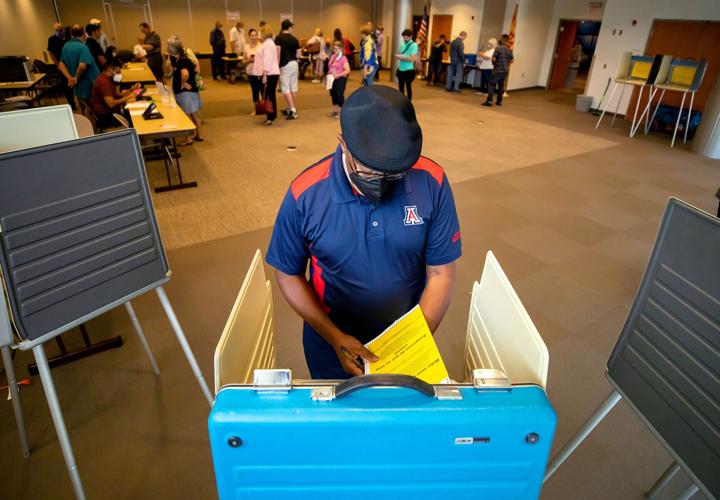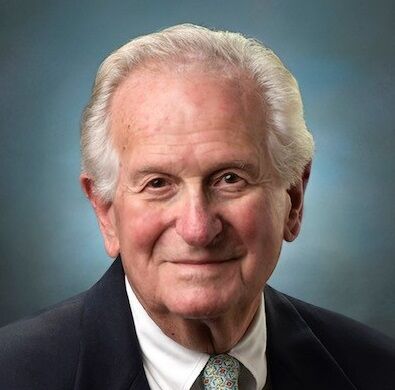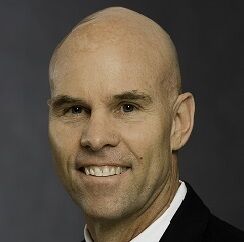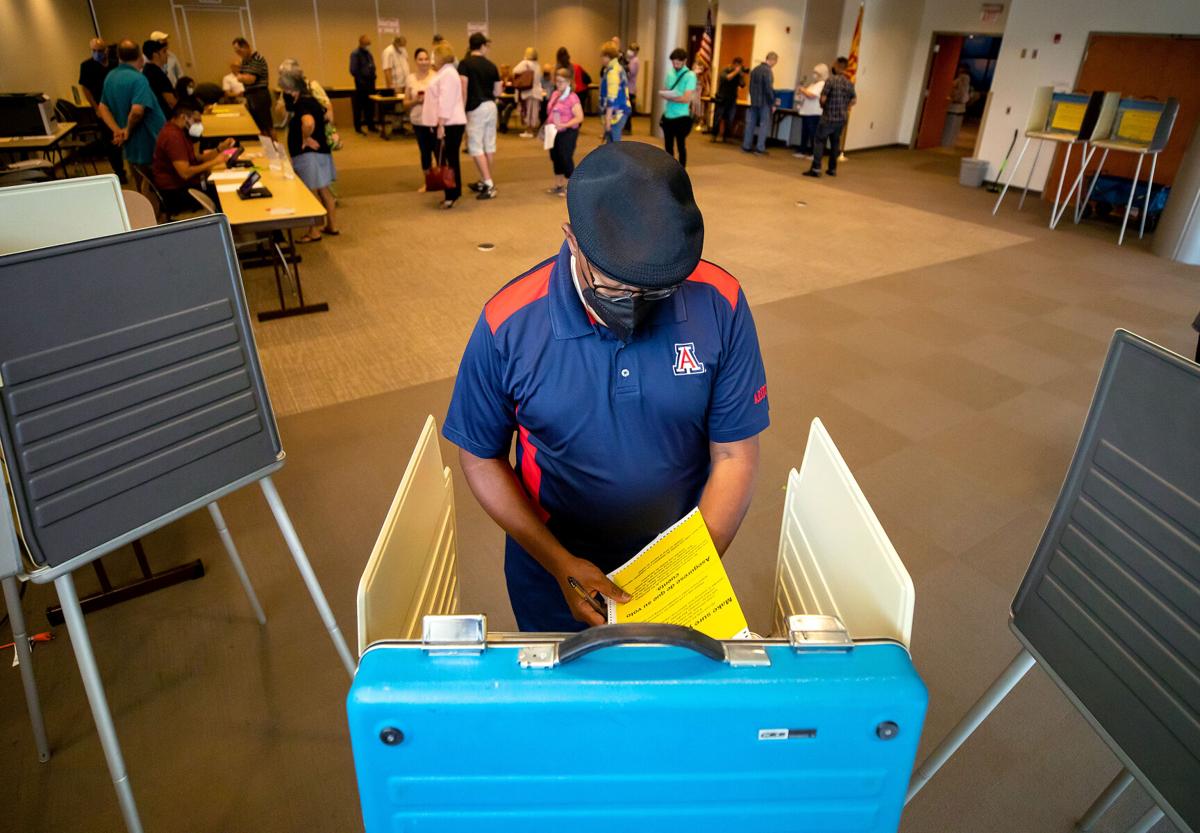An Arizona nonprofit is working to educate citizens about challenges of the current primary election system, in hopes of creating a ballot initiative that would move the state to an open, nonpartisan system.
Save Democracy is comprised of 19 Arizonans — many with connections to Tucson — who say primary elections divide citizens, discriminate against unaffiliated voters and candidates, and prevent commonsense bipartisan legislation.
Because not every election system gives all voters the opportunity to cast their ballot, according to the group, Save Democracy is raising public awareness around which systems do and do not, and the consequences of those that don't.
Members include former U.S. Rep. Ron Barber, Pima County Supervisor Rex Scott and founding chair of the Pima County Regional Transportation Commission, Si Schorr.

The group will be listening to suggestions, examining what's working in other jurisdictions, and identifying election reforms for Arizona, with the goal of having an initiative measure on the 2024 ballot for open, nonpartisan elections they say would treat all candidates and voters equally.
Variances in voter turnout
The problem is, not many do, said Save Democracy executive board member Sarah Brown Smallhouse. "Because so few people (request a ballot), we almost have closed primaries," she said.
"This is an educational effort to raise awareness around the connection between how we elect our representatives and the results we get."
In an open primary, any registered voter, regardless of party affiliation, can vote in any one party primary. Only one candidate from each party can go on to the general election.
In a nonpartisan system, all candidates are included on the same ballot and every registered voter, regardless of party affiliation, may vote for any candidate.
Nearly 11 million independent voters are prohibited from voting in 10 states with closed primaries, and another 19 states prohibit voters registered with one party from voting in another party's primary election.
This often results in minority party voters being excluded from the election that matters the most in electing their representative, says Unite America, a grassroots group working to bridge the growing partisan divide and foster a more representative and functional government.
Unite America reported that in 2020, turnout in nonpartisan primaries averaged 36.2%, significantly higher than in most open, semi-open, semi-closed or closed primaries, for which turnout data varies.
Despite operating under a semi-closed system, Arizona's system saw turnout on par with that of nonpartisan primaries that year, thanks to a surge in voter turnout. In 2020, 36% of registered Arizona voters cast ballots in the primary, an increase of about 10% over the 2018 primary and 25% more than in 2016, according to the Arizona Secretary of State's Office.
In Pima County, roughly 43% of registered voters cast ballots in the 2020 primary election, up just 3% from 2018's primary, according to the County Elections Department.
Texas has an open primary system, but only 18% of registered voters cast primary ballots in this year's midterm election. Despite that percentage being higher than in the last six midterm primaries, it still meant that fewer than one in five registered voters participated, the Texas Tribune reported.
Different rules for candidates
In Arizona, if you don't cast a vote in the primary election, essentially your vote in the November general election doesn't count, said Save Democracy executive board member and Tucson attorney Ted Hinderaker.
Hinderaker got his first taste of the political scene during a legislative internship in college, when it was very different.
"At that time, people worked together across the aisle. The system seemed to work," he said of his experience, which included working for a variety of candidates who all lost in primary elections. "It dawned on me over the years that it's not enough to have good people run and that we have to reform the system."
Hinderaker said the group's efforts are not partisan, a misconception its members sometimes hear, but that they're working to change the system so that it works for everybody.
"This gives the candidate a chance to address issues instead of just towing the party line," he said.
Smallhouse said the core of the issue is the state's low turnout in primary elections, which are often stacked with candidates who are "highly motivated and often, well-funded."
And then, when the general election rolls around, it doesn't matter as much as the primary did in who wins the seat, because there are so many uncompetitive districts, she said.
"Primaries have been designed to exclude people," she said. "If you're an active, engaged, civic person and you're registered as an independent and don't request a ballot, that's sort of the end of the story."
Independent voters represent a large part of today's population, making the current system unfair to independent or unaffiliated voters, as well as to candidates who are not running under one of the two major parties, Smallhouse said.
A 2021 Gallup poll found that 42% of Americans identified as independent.
And as of April 2022, nearly 34% of Arizonans were registered as "other," a category that includes independent voters, secretary of state records show.
In Pima County, there were 198,056 voters registered as "other," a higher number than registered Republicans, as of July 25, according to the Pima County Recorder's Office. The "other" category represents 32% of the 624,028 registered voters in the county.
"There are much higher requirements to get on the ballot, and they're often not included in debates," Smallhouse said of candidates from outside of the two major parties. "This gives an edge to the two main political parties and agendas which are often nationally driven and not locally driven."
Signature requirements are higher for unaffiliated candidates than for Democratic or Republican candidates.
Independent candidates in Arizona are required to get a number of signatures that is equal to at least 3% of all registered voters who are not affiliated with a recognized political party. However, the affiliation of people signing the petition doesn't matter. For candidates running as a Republican or Democrat, the signature requirement varies by office. Candidates running for U.S. senator or a state executive position must get signatures equal to 0.25% of registered voters. For candidates for U.S. representative or state legislative offices, the requirement is 0.5% of registered voters.
Moreover, candidates from other parties don't have access to other parties' voter rolls and don't get as much clean election money, Hinderaker said.
In Arizona, the Clean Elections Commission provides an optional public financing program to qualified statewide and legislative candidates. Candidates must meet requirements including collecting a certain number of $5 qualifying contributions and agreeing not to accept contributions from PACs and corporations.
But independent candidates can only receive 70% of the combined primary and general election funding amounts. For example, in 2022, a Democratic or Republican candidate will receive a combined total of $43,233, while an independent candidate is only eligible for $30,263, according to the committee's website.
Alternative systems in place
While most other jurisdictions have worked to change the primary system for municipal elections, Tucson has not, said Schorr, who has been involved in local politics for decades.
"Every city in Arizona has an open, nonpartisan primary except for Tucson," Schorr said. "It's worked so well, people don't even understand that they're the beneficiaries of the system."
Save Democracy is working to develop the details of the ballot initiative and trying to figure out which system is best for Arizona.
Both California and Washington have top-two primary elections, where the top two vote-getters advance to the general election, Hinderaker said.
Washington's top-two primary system was passed into law by voters in 2004 with nearly 60% of the vote. The two candidates who receive the most votes during the primary election move on to the general election, which sometimes results in two candidates from the same party facing off. Washington's top-two primary does not apply to elections for president or vice president, nonpartisan offices or special districts.
In 2003 — before the law took effect — voter turnout in the primary election was just 18%. By 2008, voter turnout in Washington's primary election was up to 43%, and in 2020, it jumped to nearly 55%, according to data from the Washington secretary of state.
California's top-two primary system was approved by voters in 2010 and rolled out for the first time statewide two years later. A decade after its passage, critics say the system too regularly produces confusing results, makes primary races more expensive and therefore dependent on big spending by public interest groups and is prone to other issues, Cal Matters reported in June.
Barbara Norrander, a professor in the University of Arizona's School of Government and Public Policy, said evidence from California's top-two system doesn't show that the candidates being nominated are more moderate candidates, which advocates claimed would happen under the change.
"Voters generally vote for the candidate they prefer. They don't strategically vote for a candidate that may be more competitive in the general election," she said.
Another issue under the top-two system is candidate crowding, according to Norrander, even though it's a nonpartisan system. In a Republican-leaning district, if four Republicans decide to compete and two Democrats, the candidates will likely split the vote several ways, she said.
"Quite possibly the people who get nominated could both be Democrats, or it could be the one Democrat or the more extreme Republican," Norrander said. "The candidates that run under that system aren't going to be much different than under a partisan primary."
In 2020, Alaska voters approved an initiative to establish a nonpartisan pick-one primary election system to implement ranked choice voting in the general election. In each race, voters will rank their choices in order of preference with votes counted in rounds. During the first round, the Alaska Division of Elections counts all first choices. If a candidate gets 50% plus one vote in round one, that candidate wins and the counting stops. If no candidate achieves that number of votes, the voting goes to round two.
For round two and beyond, the candidate with the fewest votes gets eliminated. If a person voted for that candidate, their vote goes to their second choice and the voter still has a say in who wins. If a person's first choice candidate was not eliminated, their vote stays with that candidate and votes are counted again. This keeps happening in rounds until two candidates remain and the one with the most votes wins.
Advocates of the change told radio station KTOO this year's primary was a "big success," saying there was a "wide and diverse candidate list."
Voter turnout for the June primary — the state's first by-mail election — was 27%, according to the Alaska Division of Elections, with KTOO reporting it was the highest voter turnout for a primary since 2014.
UA professor Norrander said there's not as much evidence to gauge how the system works or the outcomes of the change when it comes to ranked choice voting. Most ranked choice systems exist within local offices, she said. San Francisco, Minneapolis and about 20 other cities all use ranked choice voting.
In addition to Alaska, Maine also has a ranked choice voting system, but both states still have partisan primaries, Norrander said.
The one benefit to a ranked choice system, according to Norrander, is that eventually, the outcome is a candidate supported by the majority.
"That doesn't mean that the majority choice is more moderate, since voters don't necessarily rank candidates from moderate to more ideologically extreme," Norrander said. "People have different preferences based on geography or name recognition."
She said that while primary election voters are often described as a small portion of the population who have different views than general election voters, data shows that two-thirds of general election voters voted in the primary.
Nevada residents will be voting on an initiative to change the state's election system in November. The measure would establish a top-five primary and ranked choice. Efforts are also underway in Missouri to change the way citizens vote in primary elections.
"There's a groundswell to do this," Hinderaker said. "And we wouldn't have to change that many states to change what's happening in Washington, D.C., as well, given how narrowly split the Senate and House are."
Hinderaker said the byproduct of an open, nonpartisan system is elections that are more fair and independent, and campaigns that are less divisive.
"What it takes to win in the primary election is to be an extreme in your party," Save Democracy executive board member Don Budinger said.
But an open primary rewards candidates whose messages speak to the largest number of people, he said.
Open elections also result in diversity in candidates and voters, according to Smallhouse.
Additional questions remain
Smallhouse called Save Democracy's efforts a long game, saying that even if they do get an initiative on the 2024 ballot and voters approve it, the change wouldn't take effect until 2025. From there, it would take a few election cycles for people to catch on and for real change to take place.
"It's a heavy lift to get this done," Smallhouse said, adding that because the group is proposing an amendment to the state's constitution, the signature requirement is high. But she added, "Lots of groups in Arizona and nationally are concerned about politics in America today."
Even if the initiative does pass, the group is prepared for legal challenges, despite the fact they're not currently aware of any organized opposition to their efforts.
A representative of the Pima County GOP did not respond to the Star's request for comment about the idea of moving to an open, nonpartisan system.
The chairwoman of the Pima County Democratic Party, Bonnie Heidler, said that while her group hasn't heard from Save Democracy, it has had other presentations about various ways to hold elections.
She said that while she's open to exploring a change to the system, she sees a bigger barrier to improved election results than the state's semi-closed primary — the roles partisans play in redistricting.
"That's an area where we've tried to make it nonpartisan, but unfortunately we have not reached that goal. In Pima County, there are districts that have been gerrymandered," she said. "We could change how we do voting to be any way we want it, but until we fix the redistricting problem, I'm not sure how it will make a difference."
Save Democracy members believe partisan redistricting and partisan primaries, while different, are related issues, Hinderaker said.
For a variety of reasons, 80% to 90% of Arizona districts are noncompetitive. In a district with a Republican voter advantage, the Republican candidate who wins the Republican primary election will almost always win the general election, and the same principle applies for Democrat-dominated districts, he said.
"To get elected, a candidate only has to appeal to those voters in his or her party who vote in the party-controlled primary, and these tend to be the most ideologically rigid voters. All other voters can safely be ignored because the candidate is assured of victory in the general election," Hinderaker said.
In a single-choice nonpartisan primary election, independent voters — who will soon become the single largest voting bloc — would not have to request a ballot for each primary election and therefore would be more likely to participate, Hinderaker said.
In addition, instead of appealing to only their party's base, candidates would be incentivized to address issues and concerns that are important to a wider spectrum of voters in their district, he said.
"Although the successful candidate would likely still be a Republican in a Republican-dominated district or a Democrat in a Democrat-dominated district, to win, the candidate would have to focus on issues rather than just party loyalty and would be free to vote their conscience without the threat by party bosses of being 'primaried' in the next election cycle," Hinderaker said.
"Instead of always voting strictly along party lines, legislators would have more freedom to enact bipartisan and commonsense legislation."
Smallhouse said the group's plan to implement change is a multi-stage approach, but they can see a path to victory at every stage.
"We are committed to the conclusion that if we don't do this, we're enabling a bad system to exist," she said. "This is about empowering all voters and giving all voters and all candidates a chance."
"If you feel disaffected, if you feel like the system has left you out, if you feel like your voice doesn't matter, it matters to us," Smallhouse said. "We want you involved."















